Features
Mastering Showbiz – Moving to Fashion Productions
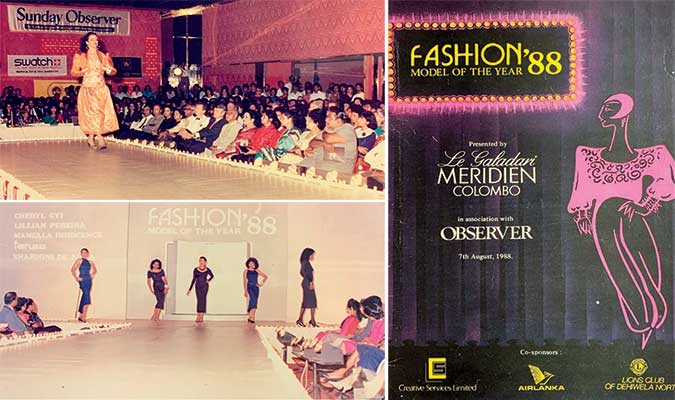
CONFESSIONS OF A GLOBAL GYPSY
Dr. Chandana (Chandi) Jayawardena DPhil
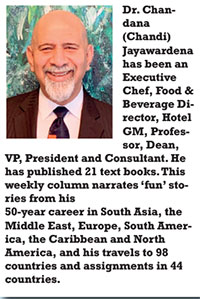
President – Chandi J. Associates Inc. Consulting, Canada
Founder & Administrator – Global Hospitality Forum
chandij@sympatico.ca
Creating ‘The Fashion Model of the Year’
In showbiz, it is always easy to follow in the footsteps of others. However, I realized that doing something new and innovative, which will be known as the ‘First-ever in a country’ needed much more attention to details, planning, cue sheets and coordination.
From my occasional chats with Senaka de Silva, while in Oman, stemmed the first-ever ‘Fashion Model of the Year’ competition in Sri Lanka. A new show was conceptualized soon after we returned from Oman. Within six months, we created a new competition and a major finale show with Senaka as the choreographer, Le Galadari Meridien Hotel as the venue and host and myself as the Producer.
I was entering an area of showbiz for which I had no expertise, other than being an occasional model mainly for TV. Therefore, my partnership with the best-known choreographer in Sri Lanka, with various other artistic talents, proved to be fruitful. After a few rounds of brainstorming, Senaka and I decided that the first step would be to run a month-long training program for aspiring fashion models. Senaka would be the trainer and I would look after all of the logistics.
Sponsors, Recruiting and Training
I had good success during my first round of negotiations with the Sunday Observer newspaper and the national carrier, Air Lanka, who became the main sponsors. I entered into partnerships with a few other secondary sponsors. At a very early stage in the process, we announced in the newspapers what the winner of the ‘Fashion Model of the Year’ competition for 1988 would receive as her rewards, all of which were very attractive.
We confirmed that in addition to the trophy, the winner would receive a return air ticket to Paris, the fashion capital of the world, a one week stay at Le Meridien in Paris, study visits to the leading fashion houses in Paris, an expensive watch and a gold-plated crown, etc. In addition, we arranged many other prizes including return air tickets to Paris, Bangkok and Singapore, for the most popular model, the most photogenic model and runner-up models.
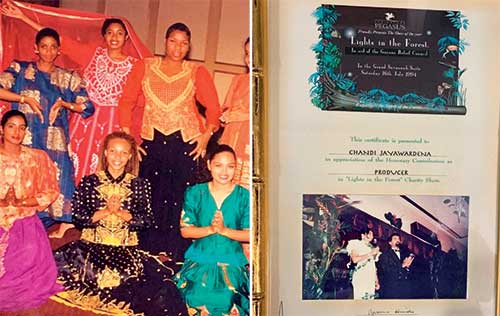
That did the trick! We received over 100 applications from young ladies aspiring to be fashion models and were willing to pay the hotel for their one-month long, professional training. Senaka and I selected around 60 applicants for an interview. After that we chose 36 to go through the training, knowing that we needed only a maximum of 25 fashion models for the final show. Each of those young ladies had to work hard to make it to the final 25.
Senaka is a very versatile, talented, demanding and strict model trainer. I was pleased to see how these young ladies blossomed every week in learning to talk, smile, walk, turn, and move with poise. They were also given useful tips on make-up, hair styling, trends of fashion in dresses, jewellery etc. Those who successfully completed the course were awarded certificates. After the competition was over about half of them became professional fashion models.
Key Partners
On Senaka’s recommendation, we recruited one of the best hairdressers and make-up artists in Sri Lanka – Ramzi Rahaman, and five, top fashion designers to be on our primary team. Eventually, each designer worked with five specific models to showcase their latest creations. Our fashion designers were: Cheryl Gyi, Lilian Pereira, Mangala Innocence, Nayantara Fonseka and Sharmini de Silva. All of them were friends, but a couple had a little professional jealousy issue, which is normal with highly creative people. The competitive spirit we instilled in them during the project, helped to enhance the creativity and with the success of the show.
While Senaka focused on the key aspects of fashion and catwalk model training, I concentrated on finding other partners for the show. Having been a judge for a few beauty contests etc., I clearly knew that a high profile and reputation of the judges were extremely important to any contest. I confirmed eight judges from eight fields. They included, Rosy Senanayake – former Miss Sri Lanka & Mrs. World; Swarna Mallawarachchi – award-winning film actress & former model; Khema – well-known classical dancer; and D. B. Nihalsinghe – award winning film director, cinematographer, editor & producer.
My recent experience in producing a dozen music shows with Sri Lankan entertainers, and café theatres with French, British and German showbiz personalities for Le Meridien was very useful. I carefully picked other professionals, such as comperes/hosts, musicians and specialists for sound, lighting and set creation. My regular and reliable partner in stage management, Kenneth Honter, was the stage coordinator. In addition to his key tasks, Senaka offered to perform as the lead dancer with his group (Senaka de Silva Dance Theatre) for three special acts in the show.
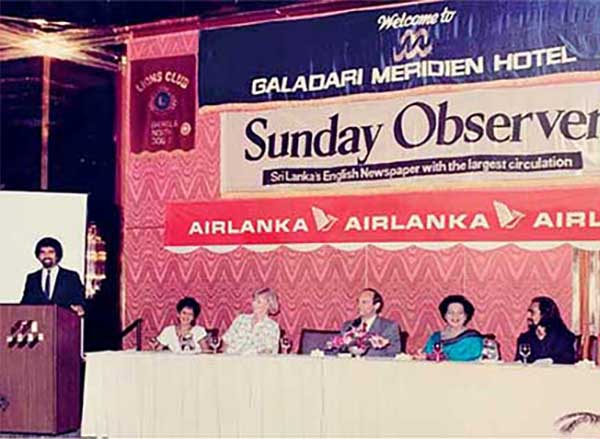
Promotion
With my team, I created a series of ‘newsworthy’ stories leading up to the day of the show. We arranged TV publicity for a mini show that Senaka did with the models after the final media briefing, held a week before the show.
The hotel dedicated one of its monthly newsletters for the show. Next to the show ticket sales desk in the lobby, I arranged a large poster with 36 photographs of the competing fashion models and one short tag line: “The Most Exciting Event of the Year!”
Production
On the final day of the event, for two hours prior to the start of the show, we held an exhibition of fashion dresses created by the five fashion designers featured in the show. This was held in the pre-function area just outside the ballroom, which was the venue for the show. This last-minute addition, encouraged keen attendees to arrive early and spend money on buying dresses, while sipping champagne and cocktails.
Our Show opened promptly at 7:00 pm as advertised, with a performance by Noeline Honter with a new original song that she had composed specially for the event – ‘Catwalk People’. Noeline was backed by the well-known musician Suryakumar, who did the arrangements for the song. Senaka’s dance routine enhanced the opening act. Including the 25 models, we had 54 persons involved in production and the performance side of the show. In addition, an army of hotel workers I led as the Director of Food & Beverage of Le Galadari Meridien Hotel, looked after the logistics.
At the end of the show, on the stage, I thanked Senaka de Silva publicly for his untiring efforts in developing the concept with me, training the models and his other professional contributions. He was the star! It was truly his show, to which I had contributed a little in leading the production and promotional aspects. In later years, in addition to being the trainer and choreographer, Senaka also became the producer of the annual ‘Fashion Model of the Year’ competitions and shows held at the same venue from 1991 to 1998.
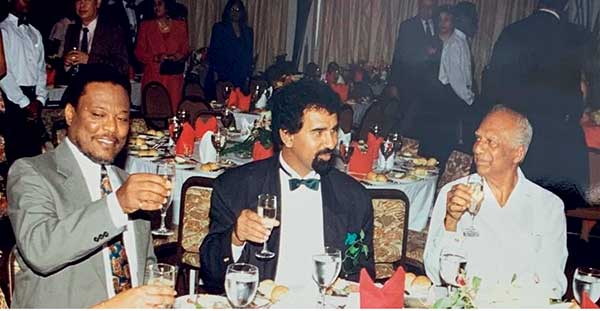
Review
I did a complete review of the show the day after the event, comparing actual results with our predictions and estimates. In terms of the quality of the production, above board judging, classy entertainment, customer satisfaction and profitability, the event proved to be an outstanding success. Our breakeven point was only 372 tickets and we sold over 800. In addition, food and beverage sales before the show, during the intermission and after show, exceeded our expectations. The 24-hour coffee shop at Le Meridien was packed for late dinner that day with thhose present for the event. August 7, 1988 was a record-breaking Sunday for our night club – Colombo 2000.
I also made an analysis along with suggested improvements for future fashion events. I noted that expenses were mainly professional fees (40%), production cost and music (35%) and promotion and overheads (25%).
Thanks to many sponsorship deals that we successfully negotiated, the first ever ‘Fashion Model of the Year’ event in Sri Lanka was highly profitable and generated an unprecedented volume of free publicity for the hotel over a period of three months.
The very next day, I was happy to receive a personal note from Mr. R. Bodinagoda, the Chairman of the Associated Newspapers of Ceylon Limited (Lake House), which published many leading newspapers including the ‘Observer’.
The note included the following paragraph: “A line to congratulate you on a show extremely well done. You started exactly on time irrespective of whether certain important guests had arrived. The show itself went off smoothly without delays. The models came on correctly and moved well and all those responsible did a good job, for which you have to be congratulated.”
Six Years later in South America…
That 1988 experience in producing the first-ever ‘Fashion Model of the Year’ event helped me in other occasional fashion industry events I got involved in later years as a hotel General Manager in Sri Lanka, Guyana and Jamaica. One such event became the biggest fund raiser in Guyana up to 1994, when I produced a unique stage show themed: ‘Lights in the Forest’. That single show helped me enormously to have great public relations and mix with different levels of the society of Guyana.
In March 1994, I was recruited as an internationally mobile (expatriate) manager of the largest British hotel company at that time – Forte PLC. My first assignment with them was to manage two unique hotels in South America. I was the General Manager of the only five-star hotel in Guyana – Forte Crest Guyana Pegasus (later Le Meridien) and Timberhead – a leading eco-resort in the Amazon Rainforest.
A few days after I arrived in Guyana, I was invited to a house party in an affluent area of the capital city – Georgetown. A lady who sat next to me at dinner, introduced herself as Yvonne Hinds, the Chairperson of the Guyana Relief Council (GRC). Her husband was the Prime Minister of the country – Dr. Sam Hinds.
“I read about you in today’s Stabroek News. You have a colourful background. Apart from being a busy international hotelier, you are also an artist, published writer, award-winning composer and a stage producer. Can you produce high-level show to raise funds for GRC?” Mrs. Hinds did not waste any time in getting to the point. I knew that working with the Prime Minister’s wife on a fund-raising project would be an excellent, public relations opportunity for the hotel.
“Certainly, I can do that, madam. What is the role of GRC?” She answered me: “It is a charitable, non-governmental organization which renders assistance to anyone whose life becomes disrupted by any form of disaster. We like to provide 100% coverage for all house fires, which are common in Guyana, as most of our houses are built mainly with wood.”
Considering the need to be practical, I told Mrs. Hinds, “I would like to do a big show with an appropriate theme for Guyana. However, I arrived here from Asia, only three days ago. Therefore, I do not know anyone with connections and talents in Guyanese showbiz. I need a little time to get to know relevant experts in Guyana”
As I was attempting to get a little breathing space, a beautiful young lady, fashionably dressed, who was seated close to us said, “I will help you and introduce Chandi to relevant people here to produce a big show at the Pegasus.” Mrs. Hinds was quick to introduce the lady to me. “This is Supriya Singh, who did a lot of interior design work for the Pegasus. Supriya has returned home from her travels and studies in Italy, Canada and England. She will arrange all the assistance you need to produce your first show in Guyana.”
Supriya became my co-producer and helped me to recruit the who’s who of the showbiz and fashion scene of Guyana. Within four months of that chat at a house party, we produced a mega show themed, ‘Lights in the Forest’ in the style of a Champagne dinner theatre in the ballroom of Forte Crest Guyana Pegasus. It was a different experience compared to a normal fashion show.
Guyana is similar to the United Kingdom in land size, but most of the population of 750,000 lived on the coastal plain, which occupies about five percent of the country’s area. The rest of the country was virgin rainforest, a part of the Amazon, shared by eight countries. Therefore, protecting the rainforest was suggested as a major theme of ‘Lights in the Forest’ show.
In addition to showcasing the ethnic diversity of Guyana (Amerindian, European, African, Indian and Chinese), we included a deeper meaning of protecting mother nature by ensuring that development is done sustainably. In the last scene when a dancer performed as an evil force trying to destroy the rainforest (mother nature), I arranged for a dozen high commissioners/ambassadors/country representatives and/or their spouses to appear on stage in their national costumes. They held hands and formed a line.
The last person in the line was my wife in a Kandyan saree representing Sri Lanka. When she touched the palm of the dying mother nature, she miraculously came back to life. At that point, the evil spirit leaves the rainforest in fear of the world uniting to protect mother nature. The show ended there and received a standing ovation by all present.
The diplomats and locals loved the theme and the production of the show. We presented it without any spoken words, but with subtle background music and dances reflecting different ethnic populations of Guyana. That night, through show ticket sales, we raised G$820,000 for GRC, which was an all-time record in Guyana. A week after the show, my superiors from the United Kingdom (Managing Director and Regional Vice President) were invited to accompany me to present a cheque for G$820,000 to Mrs. Hinds, at the Prime Minister’s residence.
Guyana’s President – Dr. Cheddi Jagan and Prime Minister – Dr. Sam Hinds insisted that I join the head table during the dinner and show and sit between two of them. During my two years in Guyana and subsequent assignments in the Caribbean, they both, as well as their wives, continued a warm friendship with me.
In 2000, I published my first article in a double peer reviewed, academic journal. That Le Meridien experience in the mid-1980s strongly shaped my attitude about international hotel management. In that ‘viewpoint’ article, I stated: “International hotel management is similar to ‘Showbiz’. It is hard work, lots of practice, and (well planned) fun! Eventually the success of a show or hotel’s operation is measured from the profits. The creativity and public relations of the manager and his/her team have to be translated to profits. Hotel management is a profitable art.”
Jayawardena, C. (2000), “International hotel manager”, International Journal of Contemporary Hospitality Management, UK, Vol.12 No 1, pp. 67-69.
I was always treated as a fellow Guyanese by many of my friends in that beautiful country. In 2007, on an invitation by then President of Guyana – Dr. Bharrat Jagdeo, I became a consultant to the government of Guyana. The important task entrusted to me was to open the largest hotel in that country – Buddy’s International Hotel (now Ramada Princess) as the Hotel Opening General Manager and to host the Rio Summit of Heads of State and Government, and VIPS attending the World Cup Cricket 2007. In 2023, I happily accepted an invitation by the University of Guyana to join the Editorial Board of their first refereed journal on Tourism. People meeting people, and establishing life-long friendships is the most beautiful aspect of Tourism.
Features
The heart-friendly health minister

by Dr Gotabhya Ranasinghe
Senior Consultant Cardiologist
National Hospital Sri Lanka
When we sought a meeting with Hon Dr. Ramesh Pathirana, Minister of Health, he graciously cleared his busy schedule to accommodate us. Renowned for his attentive listening and deep understanding, Minister Pathirana is dedicated to advancing the health sector. His openness and transparency exemplify the qualities of an exemplary politician and minister.
Dr. Palitha Mahipala, the current Health Secretary, demonstrates both commendable enthusiasm and unwavering support. This combination of attributes makes him a highly compatible colleague for the esteemed Minister of Health.
Our discussion centered on a project that has been in the works for the past 30 years, one that no other minister had managed to advance.
Minister Pathirana, however, recognized the project’s significance and its potential to revolutionize care for heart patients.
The project involves the construction of a state-of-the-art facility at the premises of the National Hospital Colombo. The project’s location within the premises of the National Hospital underscores its importance and relevance to the healthcare infrastructure of the nation.
This facility will include a cardiology building and a tertiary care center, equipped with the latest technology to handle and treat all types of heart-related conditions and surgeries.
Securing funding was a major milestone for this initiative. Minister Pathirana successfully obtained approval for a $40 billion loan from the Asian Development Bank. With the funding in place, the foundation stone is scheduled to be laid in September this year, and construction will begin in January 2025.
This project guarantees a consistent and uninterrupted supply of stents and related medications for heart patients. As a result, patients will have timely access to essential medical supplies during their treatment and recovery. By securing these critical resources, the project aims to enhance patient outcomes, minimize treatment delays, and maintain the highest standards of cardiac care.
Upon its fruition, this monumental building will serve as a beacon of hope and healing, symbolizing the unwavering dedication to improving patient outcomes and fostering a healthier society.We anticipate a future marked by significant progress and positive outcomes in Sri Lanka’s cardiovascular treatment landscape within the foreseeable timeframe.
Features
A LOVING TRIBUTE TO JESUIT FR. ALOYSIUS PIERIS ON HIS 90th BIRTHDAY

by Fr. Emmanuel Fernando, OMI
Jesuit Fr. Aloysius Pieris (affectionately called Fr. Aloy) celebrated his 90th birthday on April 9, 2024 and I, as the editor of our Oblate Journal, THE MISSIONARY OBLATE had gone to press by that time. Immediately I decided to publish an article, appreciating the untiring selfless services he continues to offer for inter-Faith dialogue, the renewal of the Catholic Church, his concern for the poor and the suffering Sri Lankan masses and to me, the present writer.
It was in 1988, when I was appointed Director of the Oblate Scholastics at Ampitiya by the then Oblate Provincial Fr. Anselm Silva, that I came to know Fr. Aloy more closely. Knowing well his expertise in matters spiritual, theological, Indological and pastoral, and with the collaborative spirit of my companion-formators, our Oblate Scholastics were sent to Tulana, the Research and Encounter Centre, Kelaniya, of which he is the Founder-Director, for ‘exposure-programmes’ on matters spiritual, biblical, theological and pastoral. Some of these dimensions according to my view and that of my companion-formators, were not available at the National Seminary, Ampitiya.
Ever since that time, our Oblate formators/ accompaniers at the Oblate Scholasticate, Ampitiya , have continued to send our Oblate Scholastics to Tulana Centre for deepening their insights and convictions regarding matters needed to serve the people in today’s context. Fr. Aloy also had tried very enthusiastically with the Oblate team headed by Frs. Oswald Firth and Clement Waidyasekara to begin a Theologate, directed by the Religious Congregations in Sri Lanka, for the contextual formation/ accompaniment of their members. It should very well be a desired goal of the Leaders / Provincials of the Religious Congregations.
Besides being a formator/accompanier at the Oblate Scholasticate, I was entrusted also with the task of editing and publishing our Oblate journal, ‘The Missionary Oblate’. To maintain the quality of the journal I continue to depend on Fr. Aloy for his thought-provoking and stimulating articles on Biblical Spirituality, Biblical Theology and Ecclesiology. I am very grateful to him for his generous assistance. Of late, his writings on renewal of the Church, initiated by Pope St. John XX111 and continued by Pope Francis through the Synodal path, published in our Oblate journal, enable our readers to focus their attention also on the needed renewal in the Catholic Church in Sri Lanka. Fr. Aloy appreciated very much the Synodal path adopted by the Jesuit Pope Francis for the renewal of the Church, rooted very much on prayerful discernment. In my Religious and presbyteral life, Fr.Aloy continues to be my spiritual animator / guide and ongoing formator / acccompanier.
Fr. Aloysius Pieris, BA Hons (Lond), LPh (SHC, India), STL (PFT, Naples), PhD (SLU/VC), ThD (Tilburg), D.Ltt (KU), has been one of the eminent Asian theologians well recognized internationally and one who has lectured and held visiting chairs in many universities both in the West and in the East. Many members of Religious Congregations from Asian countries have benefited from his lectures and guidance in the East Asian Pastoral Institute (EAPI) in Manila, Philippines. He had been a Theologian consulted by the Federation of Asian Bishops’ Conferences for many years. During his professorship at the Gregorian University in Rome, he was called to be a member of a special group of advisers on other religions consulted by Pope Paul VI.
Fr. Aloy is the author of more than 30 books and well over 500 Research Papers. Some of his books and articles have been translated and published in several countries. Among those books, one can find the following: 1) The Genesis of an Asian Theology of Liberation (An Autobiographical Excursus on the Art of Theologising in Asia, 2) An Asian Theology of Liberation, 3) Providential Timeliness of Vatican 11 (a long-overdue halt to a scandalous millennium, 4) Give Vatican 11 a chance, 5) Leadership in the Church, 6) Relishing our faith in working for justice (Themes for study and discussion), 7) A Message meant mainly, not exclusively for Jesuits (Background information necessary for helping Francis renew the Church), 8) Lent in Lanka (Reflections and Resolutions, 9) Love meets wisdom (A Christian Experience of Buddhism, 10) Fire and Water 11) God’s Reign for God’s poor, 12) Our Unhiddden Agenda (How we Jesuits work, pray and form our men). He is also the Editor of two journals, Vagdevi, Journal of Religious Reflection and Dialogue, New Series.
Fr. Aloy has a BA in Pali and Sanskrit from the University of London and a Ph.D in Buddhist Philosophy from the University of Sri Lankan, Vidyodaya Campus. On Nov. 23, 2019, he was awarded the prestigious honorary Doctorate of Literature (D.Litt) by the Chancellor of the University of Kelaniya, the Most Venerable Welamitiyawe Dharmakirthi Sri Kusala Dhamma Thera.
Fr. Aloy continues to be a promoter of Gospel values and virtues. Justice as a constitutive dimension of love and social concern for the downtrodden masses are very much noted in his life and work. He had very much appreciated the commitment of the late Fr. Joseph (Joe) Fernando, the National Director of the Social and Economic Centre (SEDEC) for the poor.
In Sri Lanka, a few religious Congregations – the Good Shepherd Sisters, the Christian Brothers, the Marist Brothers and the Oblates – have invited him to animate their members especially during their Provincial Congresses, Chapters and International Conferences. The mainline Christian Churches also have sought his advice and followed his seminars. I, for one, regret very much, that the Sri Lankan authorities of the Catholic Church –today’s Hierarchy—- have not sought Fr.
Aloy’s expertise for the renewal of the Catholic Church in Sri Lanka and thus have not benefited from the immense store of wisdom and insight that he can offer to our local Church while the Sri Lankan bishops who governed the Catholic church in the immediate aftermath of the Second Vatican Council (Edmund Fernando OMI, Anthony de Saram, Leo Nanayakkara OSB, Frank Marcus Fernando, Paul Perera,) visited him and consulted him on many matters. Among the Tamil Bishops, Bishop Rayappu Joseph was keeping close contact with him and Bishop J. Deogupillai hosted him and his team visiting him after the horrible Black July massacre of Tamils.
Features
A fairy tale, success or debacle

Sri Lanka-Singapore Free Trade Agreement
By Gomi Senadhira
senadhiragomi@gmail.com
“You might tell fairy tales, but the progress of a country cannot be achieved through such narratives. A country cannot be developed by making false promises. The country moved backward because of the electoral promises made by political parties throughout time. We have witnessed that the ultimate result of this is the country becoming bankrupt. Unfortunately, many segments of the population have not come to realize this yet.” – President Ranil Wickremesinghe, 2024 Budget speech
Any Sri Lankan would agree with the above words of President Wickremesinghe on the false promises our politicians and officials make and the fairy tales they narrate which bankrupted this country. So, to understand this, let’s look at one such fairy tale with lots of false promises; Ranil Wickremesinghe’s greatest achievement in the area of international trade and investment promotion during the Yahapalana period, Sri Lanka-Singapore Free Trade Agreement (SLSFTA).
It is appropriate and timely to do it now as Finance Minister Wickremesinghe has just presented to parliament a bill on the National Policy on Economic Transformation which includes the establishment of an Office for International Trade and the Sri Lanka Institute of Economics and International Trade.
Was SLSFTA a “Cleverly negotiated Free Trade Agreement” as stated by the (former) Minister of Development Strategies and International Trade Malik Samarawickrama during the Parliamentary Debate on the SLSFTA in July 2018, or a colossal blunder covered up with lies, false promises, and fairy tales? After SLSFTA was signed there were a number of fairy tales published on this agreement by the Ministry of Development Strategies and International, Institute of Policy Studies, and others.
However, for this article, I would like to limit my comments to the speech by Minister Samarawickrama during the Parliamentary Debate, and the two most important areas in the agreement which were covered up with lies, fairy tales, and false promises, namely: revenue loss for Sri Lanka and Investment from Singapore. On the other important area, “Waste products dumping” I do not want to comment here as I have written extensively on the issue.
1. The revenue loss
During the Parliamentary Debate in July 2018, Minister Samarawickrama stated “…. let me reiterate that this FTA with Singapore has been very cleverly negotiated by us…. The liberalisation programme under this FTA has been carefully designed to have the least impact on domestic industry and revenue collection. We have included all revenue sensitive items in the negative list of items which will not be subject to removal of tariff. Therefore, 97.8% revenue from Customs duty is protected. Our tariff liberalisation will take place over a period of 12-15 years! In fact, the revenue earned through tariffs on goods imported from Singapore last year was Rs. 35 billion.
The revenue loss for over the next 15 years due to the FTA is only Rs. 733 million– which when annualised, on average, is just Rs. 51 million. That is just 0.14% per year! So anyone who claims the Singapore FTA causes revenue loss to the Government cannot do basic arithmetic! Mr. Speaker, in conclusion, I call on my fellow members of this House – don’t mislead the public with baseless criticism that is not grounded in facts. Don’t look at petty politics and use these issues for your own political survival.”
I was surprised to read the minister’s speech because an article published in January 2018 in “The Straits Times“, based on information released by the Singaporean Negotiators stated, “…. With the FTA, tariff savings for Singapore exports are estimated to hit $10 million annually“.
As the annual tariff savings (that is the revenue loss for Sri Lanka) calculated by the Singaporean Negotiators, Singaporean $ 10 million (Sri Lankan rupees 1,200 million in 2018) was way above the rupees’ 733 million revenue loss for 15 years estimated by the Sri Lankan negotiators, it was clear to any observer that one of the parties to the agreement had not done the basic arithmetic!
Six years later, according to a report published by “The Morning” newspaper, speaking at the Committee on Public Finance (COPF) on 7th May 2024, Mr Samarawickrama’s chief trade negotiator K.J. Weerasinghehad had admitted “…. that forecasted revenue loss for the Government of Sri Lanka through the Singapore FTA is Rs. 450 million in 2023 and Rs. 1.3 billion in 2024.”
If these numbers are correct, as tariff liberalisation under the SLSFTA has just started, we will pass Rs 2 billion very soon. Then, the question is how Sri Lanka’s trade negotiators made such a colossal blunder. Didn’t they do their basic arithmetic? If they didn’t know how to do basic arithmetic they should have at least done their basic readings. For example, the headline of the article published in The Straits Times in January 2018 was “Singapore, Sri Lanka sign FTA, annual savings of $10m expected”.
Anyway, as Sri Lanka’s chief negotiator reiterated at the COPF meeting that “…. since 99% of the tariffs in Singapore have zero rates of duty, Sri Lanka has agreed on 80% tariff liberalisation over a period of 15 years while expecting Singapore investments to address the imbalance in trade,” let’s turn towards investment.
Investment from Singapore
In July 2018, speaking during the Parliamentary Debate on the FTA this is what Minister Malik Samarawickrama stated on investment from Singapore, “Already, thanks to this FTA, in just the past two-and-a-half months since the agreement came into effect we have received a proposal from Singapore for investment amounting to $ 14.8 billion in an oil refinery for export of petroleum products. In addition, we have proposals for a steel manufacturing plant for exports ($ 1 billion investment), flour milling plant ($ 50 million), sugar refinery ($ 200 million). This adds up to more than $ 16.05 billion in the pipeline on these projects alone.
And all of these projects will create thousands of more jobs for our people. In principle approval has already been granted by the BOI and the investors are awaiting the release of land the environmental approvals to commence the project.
I request the Opposition and those with vested interests to change their narrow-minded thinking and join us to develop our country. We must always look at what is best for the whole community, not just the few who may oppose. We owe it to our people to courageously take decisions that will change their lives for the better.”
According to the media report I quoted earlier, speaking at the Committee on Public Finance (COPF) Chief Negotiator Weerasinghe has admitted that Sri Lanka was not happy with overall Singapore investments that have come in the past few years in return for the trade liberalisation under the Singapore-Sri Lanka Free Trade Agreement. He has added that between 2021 and 2023 the total investment from Singapore had been around $162 million!
What happened to those projects worth $16 billion negotiated, thanks to the SLSFTA, in just the two-and-a-half months after the agreement came into effect and approved by the BOI? I do not know about the steel manufacturing plant for exports ($ 1 billion investment), flour milling plant ($ 50 million) and sugar refinery ($ 200 million).
However, story of the multibillion-dollar investment in the Petroleum Refinery unfolded in a manner that would qualify it as the best fairy tale with false promises presented by our politicians and the officials, prior to 2019 elections.
Though many Sri Lankans got to know, through the media which repeatedly highlighted a plethora of issues surrounding the project and the questionable credentials of the Singaporean investor, the construction work on the Mirrijiwela Oil Refinery along with the cement factory began on the24th of March 2019 with a bang and Minister Ranil Wickremesinghe and his ministers along with the foreign and local dignitaries laid the foundation stones.
That was few months before the 2019 Presidential elections. Inaugurating the construction work Prime Minister Ranil Wickremesinghe said the projects will create thousands of job opportunities in the area and surrounding districts.
The oil refinery, which was to be built over 200 acres of land, with the capacity to refine 200,000 barrels of crude oil per day, was to generate US$7 billion of exports and create 1,500 direct and 3,000 indirect jobs. The construction of the refinery was to be completed in 44 months. Four years later, in August 2023 the Cabinet of Ministers approved the proposal presented by President Ranil Wickremesinghe to cancel the agreement with the investors of the refinery as the project has not been implemented! Can they explain to the country how much money was wasted to produce that fairy tale?
It is obvious that the President, ministers, and officials had made huge blunders and had deliberately misled the public and the parliament on the revenue loss and potential investment from SLSFTA with fairy tales and false promises.
As the president himself said, a country cannot be developed by making false promises or with fairy tales and these false promises and fairy tales had bankrupted the country. “Unfortunately, many segments of the population have not come to realize this yet”.
(The writer, a specialist and an activist on trade and development issues . )












